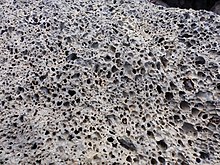Vesicular texture
(Redirected from
Vesicle (geology)
)

Vesicular texture is a
volcanic rock
texture characterized by a rock being pitted with many cavities (known as vesicles) at its surface and inside.
[1]
This texture is common in aphanitic, or glassy, igneous rocks that have come to the surface of the Earth, a process known as extrusion. As magma rises to the surface the pressure on it decreases. When this happens gasses dissolved in the magma are able to come out of solution, forming gas bubbles (the cavities) inside it. When the magma finally reaches the surface as lava and cools, the rock solidifies around the gas bubbles and traps them inside, preserving them as holes filled with gas called vesicles.
[2]
A related texture is
amygdules
(American usage) or amygdales (British usage). Sometimes these can be sources of semi-precious or precious stones such as diamonds.
Rock types that display a vesicular texture include pumice and scoria.
See also
References
- ^ See "Elmhurst College Powerpoint via google viewer" Archived October 30, 2012, at the Wayback Machine, retrieved May 8, 2011
- ^ D. Armstrong, F. Mugglestone, R. Richards and F. Stratton "OCR AS and A2 Geology". Pearson Education Limited, 2008, p. 76.
- ^ Vesicules and Amygdule, pitt.edu, accessed 14 Sept 2021.
